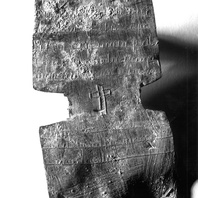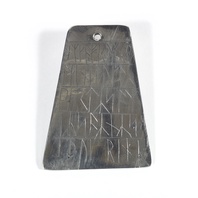
Viking Objects
Inscribed Lead Plaque (LCNCC:1996.64.045)
This lead plaque of uncertain function has a cross incised in its centre and a long Latin text in the Roman alphabet. Like the Saltfleetby spindle whorl, this inscription, too, calls on a divine power, in this case Christ. Between them the two inscriptions represent different responses to literacy and religion in the same time period in neighbouring but probably different communities. (Cumberworth is about 15 miles south of Saltfleetby, in an area with many Scandinavian place-names.) This fragmentary inscription begins with a cross and XPI, the sign for Christ, and after a gap in the text ends with ‘he who by the power of the cross redeemed the world from death, shattered hell or threw open heaven’. The object is dated to the late 10th or 11th century on the basis of the similarity of the writing to contemporary manuscripts.
Read More

Viking Objects
Reproduction Runic Plaque
The original of which this is a pewter reproduction is a folded lead plaque of a type that became very popular in Scandinavia from the late eleventh century. The runes are of the Viking Age Scandinavian type, though there appears to be one occurrence of the distinctively Anglo-Saxon ‘wynn’-rune. It is not possible to make any sense of the text, and it is possible that the writer never intended to do so. The parallels from Scandinavia include lead sheets (often folded), crosses and amulets. The runic inscriptions on these objects are often combinations of incantatory or biblical Latin, or charm language or just gibberish. The abbey of Holme St Benet is on the edge of an area in East Anglia which place-names indicate was subject to extensive Scandinavian influence.
